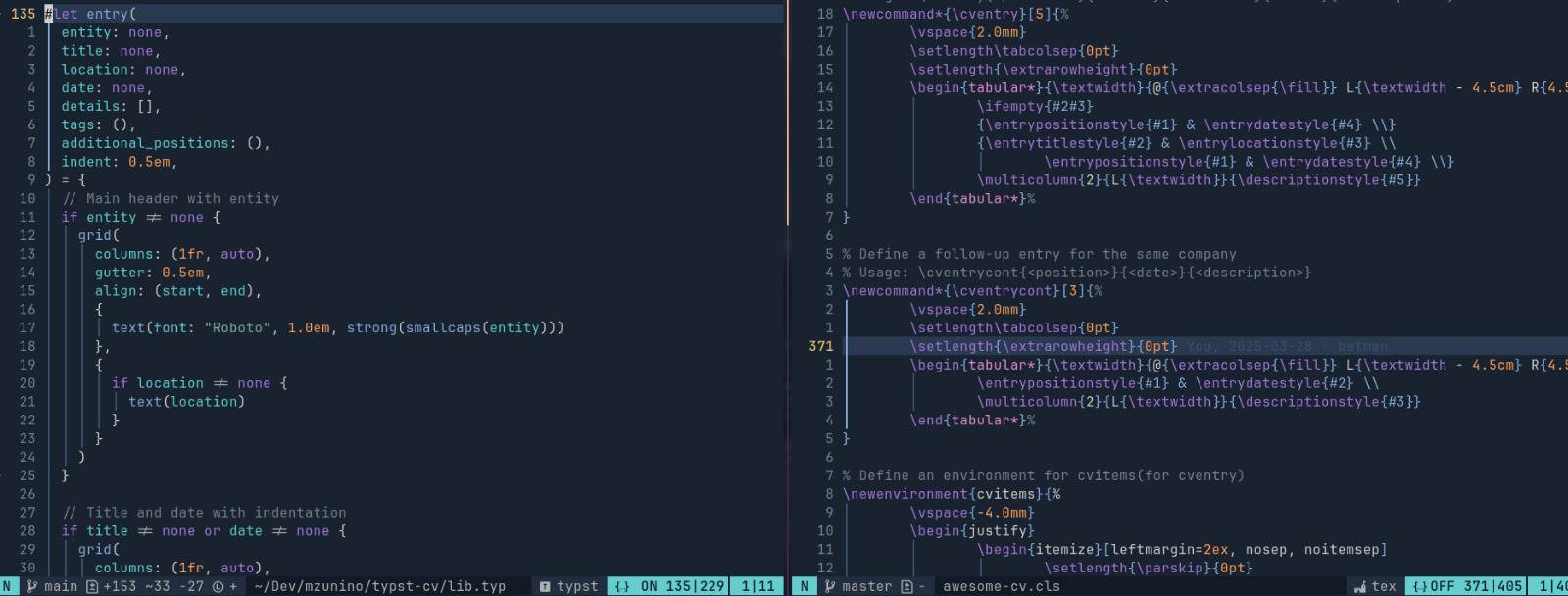Migrating from LaTeX to Typst
The LaTeX Problem
For years, I’ve used LaTeX for my CV. It worked well enough, but came with a host of frustrations:
- Slow compile times (especially with complex documents)
- Cryptic error messages that would take forever to debug
- Cumbersome syntax for custom functions and formatting
- Package conflicts that seemed to arise out of nowhere
- A steep learning curve for anything beyond basic usage
While LaTeX is powerful, these pain points had me looking for alternatives… let alone the installation on itself.
Enter Typst
Recently, I decided to migrate my CV from LaTeX to Typst, and the difference was immediately noticeable.
Typst is a modern typesetting system designed as an alternative to LaTeX. It offers:
- Lightning-fast compilation times (we’re talking milliseconds)
- A cleaner, more intuitive syntax
- Excellent error messages that actually tell you what went wrong
- Built-in versioning and collaboration tools
- No dependency hell from conflicting packages
The Migration Process
Converting my LaTeX CV to Typst was surprisingly straightforward. Here’s a before-and-after comparison of a section:
LaTeX version:
\section{Experience}
\begin{itemize}
\item \textbf{Senior Software Engineer} \hfill 2020 - Present
\begin{itemize}
\item Bla bla
\item Yada yada
\end{itemize}
\end{itemize}
Typst version:
= Experience
#entry(
[Senior Software Engineer],
[2020 - Present],
list(
[Bla bla],
[Yada yada]
)
)
Where entry is a simple function I defined:
#let entry(title, date, details) = {
grid(
columns: (1fr, auto),
gutter: 0.5em,
align: (start, end),
text(weight: "light", 1.1em, title),
text(date, style: "italic")
)
pad(left: 1em, details)
}
What I Love About Typst
1. Fast Iteration Cycles
The near-instant compilation times changed my workflow completely. With LaTeX, I would make a few changes, then wait several seconds (or even minutes with complex documents) to see the results.
With Typst, I can see changes as I type, which makes fine-tuning a document much more efficient.
Neovim Integration
I integrated Typst with my Neovim setup using the excellent typst-preview.nvim plugin:
{
"chomosuke/typst-preview.nvim",
lazy = false, -- or ft = 'typst'
version = "1.*",
opts = {}, -- lazy.nvim will implicitly calls `setup {}`
},
The real-time preview is mind-blowing - changes appear instantly in the preview window even without saving the document! This is a game-changer for productivity, especially compared to the clunky compile-preview-edit cycle I was used to with LaTeX.
3. Error Messages That Make Sense
When I make a mistake, which happens all the time, I get clear, helpful error messages:
error: unexpected type: expected length, found color
--> cv.typ:15:10
|
15 | stroke: blue,
| ^^^^ did you mean to use a different type?
Compare that to the infamous “Undefined control sequence” errors in LaTeX…
The Downsides
To be fair, there are a few areas where Typst still lags behind LaTeX:
- Ecosystem Size: LaTeX has decades of packages and templates
- Advanced Math: While Typst handles most math well, LaTeX still has an edge with very complex equations
But for my CV and most of my document needs, these limitations weren’t relevant.
Conclusion
Migrating from LaTeX to Typst has been one of those very rare transitions where almost everything is better. The speed alone makes it worthwhile, but the cleaner syntax, better error handling, and intuitive programming model push it over the top.
